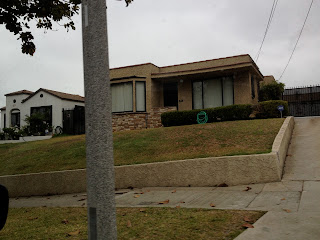This past Sunday, I went to Downtown Santa Ana in Orange County. Downtown Santa Ana is really interesting because it was one of the first major centers built in Orange County. Once suburbia started to sprawl and Orange County became this huge suburban city, DTSA started to become more isolated and this part of the city sort of became a ghost town, until it became more of a center for Latino's, with businesses that were Latino dominated.
Here is a map of Downtown Santa Ana currently.
I read an article in the
Orange County Register, that talks about the history of ethnic mixing on East Fourth Street (can be seen in the yellow square in the map above) and according to the article, East Fourth Street was starting to become a Mexican commercial district since the 1930s. Although it was primarily white through the 1940s, Mexican immigrants were already starting to populate this area. Historically the street was a mixed thing, bringing in middle-class whites and Latino customers. There used to be a JC Penny's and other economical stores located in the area. In the 1950s, most of the customers were U.S. born, of Mexican descent. After South Coast Plaza was built in the late 1960s, DTSA started to become more focused on the immigrant working class. It wasn't until the 1970s that DTSA become a sort of a ghost town, and this is when Latino shop owners came in hosting largely to Mexican immigrant customers.
Right now in Orange County, these old towns and centers are starting to become more popular and becoming more attractive to live in, especially younger couples with no children and/or older couples with grown children. I walked around DTSA looking at the mix of the Latino dominating areas, new condos and high rises, and the artist village where all the hipsters like to hang out.
Walking around the cars in the area were more economical, the landscape was very urban with some trees planted on the walkways, lots of latinos walking around, specially families. There was a lot of businesses catering to the Mexican cliental, like carts that sell mexican food and fruit, barber shops, hair salons, mexican food restaurants, clothes stores with spanish titles and even clothes stores specified for "quinceniera" (which is a mexican tradition of celebrating the birthday of girls turning 15 years old). On the outskirts of the downtown you could also see some old and dilapidated buildings.
Here is an image of the outskirts of downtown that have old dilapidated buildings and some single-style family homes at the end of the street.
Barber Shop at a street corner.
Some small businesses that cater especially to latinos.
Trees that line the streets and walk ways.
Small Salon found on a street corner.
Advertising written in spanish, targeting latino clientele.
Latino customers walking on the sidewalk.
Quinceniera clothing store.
I took a video when I was walking around, so you can kind of feel and experience the area a little bit.
In other parts of downtown there are movie theaters, bars, clubs, cafes, coffee shops, and restaurants. These areas tend to bring in a more younger crowd who like living a more city life. The Art District, is an area that tends to have more of these attractions. A lot of hipsters like to hang out here and of course there is art here!
Playground, a restaurant that has been getting a lot of hype. By the way I have ate here multiple times, and I would highly recommend it if you ever get a chance or are near the area.
Yost Theatre is one of the original buildings but now serves as a club.
One of the many new condos.
A mural in the art district.
The front of Santora building. This is a historical building here in downtown Santa Ana, which now serves as a gallery and holds several businesses.
A display of some art inside the Santora building.
One of the restaurants in the Santora Building
A cafe in the art district, including the hipster crowd.
There is a lot of controversial about the gentrification going on in DTSA. Some crowds are not happy because of new taxes and they feel that they are trying to push out the latino crowd. Some crowds like it because they like the urban feel and the new businesses that go with it. There are pros and cons to this. Pros being less violence and crime, more sales tax revenue, and the beautification of these old downtowns. Cons being that some businesses get pushed out and people loosing there homes and culture due to new developments.
What do you think is better, the gentrification being done, or just leave it the way it is?















































